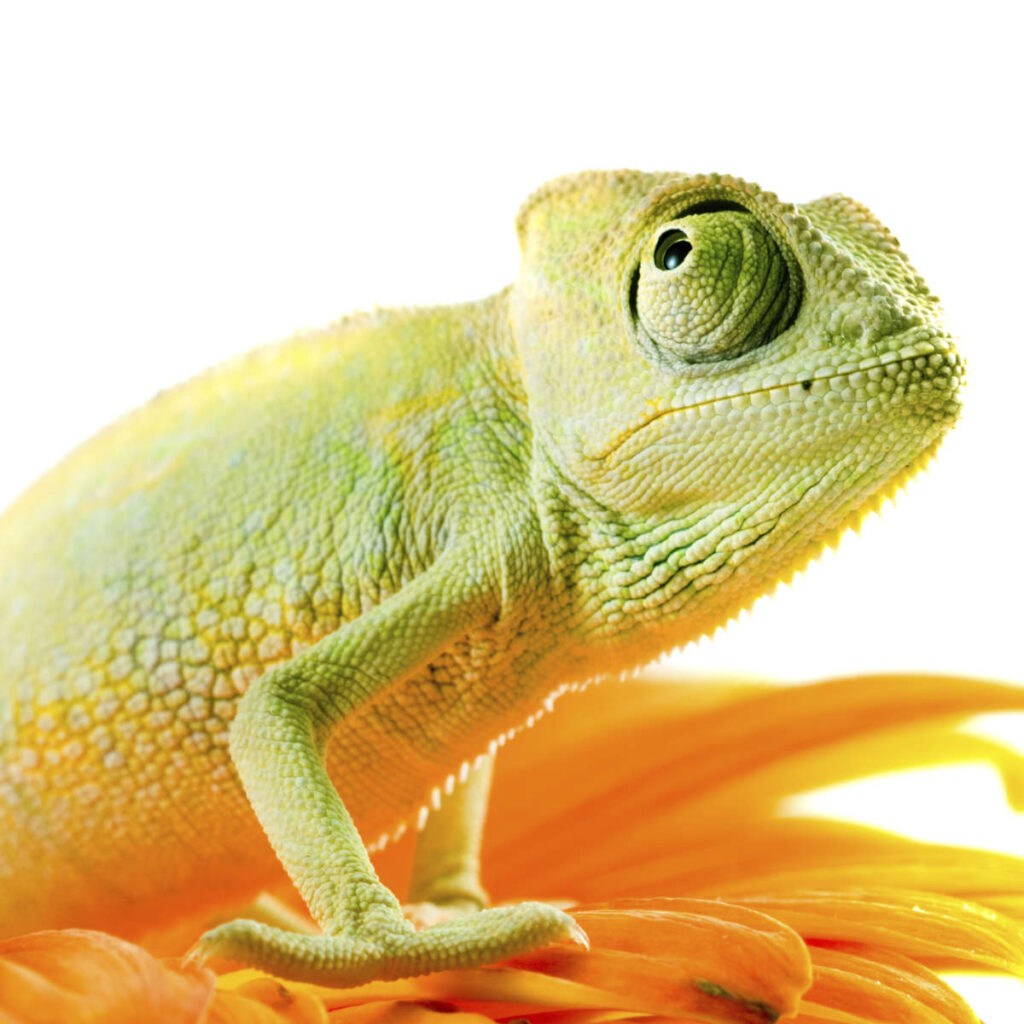Last Reviewed and Updated on July 21, 2022
Chameleons are one of the most intriguing animals in the world. The ability to change colors and move their eyes independently makes them feel pretty out of this world. Learn some of the most fun facts about chameleons, from why they change their colors to how their unique tongues work.

1. It takes about 20 seconds for a chameleon to change its color
One of the most distinctive features of these animals is their ability to change color. They can do it fairly quickly as it takes them about 20 seconds to change their color.
2. Their color change does have a function in camouflage, but this isn’t the main one
You may think their ability to change their colors is for camouflage purposes. While it does serve this purpose, too, it isn’t the main reason for their color changing. The main reason for their color changes is social signaling and a reaction to temperature changes to help them regulate their body temperature.
3. They have the longest tongue-to-body ratio
This has to be one of the coolest facts about chameleons. Out of all animals, the chameleons have the longest tongue-to-body ratio. On average, their tongues are one and a half to two times the length of their bodies, without the length of tail included. Smaller species have even longer tongues, proportionally, with their tongues being over twice their body length.
Also read: 100 weird facts about animals

4. There are over 200 different species of chameleon, most living in Madagascar
Chameleons come in many shapes, sizes, and colors. There are over 100 different species of chameleons in Madagascar.
5. The smallest chameleon is Brookesia micra, longest is Furcifer oustaleti
Brookesia micra, the Nosy Hara leaf chameleon, is the smallest known chameleon species. It’s also one of the smallest reptiles. Adults can grow up to 1.1 inch / 29 mm in length, including the tail.
Furcifer oustaleti, the Malagasy giant chameleon, is the longest chameleon species, with a maximum total length of 27 inches / 68.5 cm, including the tail.
When it comes to largest, the Malagasy giant chameleon shares 1st place with the Parsons chameleon as this one tends to be heavier but is still slightly shorter.
6. The end of their tongues form a suction cup when they fetch food
Chameleons have sticky tongues, which enables them to catch small insects as they stick to the tongue. But when it comes to larger prey, the stickiness itself isn’t enough.
When chameleons spot their prey, they shoot their tongue at them. The speed at which they release their tongue is so fast that you might completely miss it. The tip of the tongue, when released, isn’t really different from ours, but just before it reaches the prey, the tip of the tongue is retracted, making a cup shape. When the tongue hits the prey, the suction effect “catches” the prey.
7. They move in a unique swaying way
Chameleons have a unique swaying gait. These animals spend most of their time on branches, so it makes sense they adapted a gait that makes it easier for them to blend with the moving leaves, hiding them from predators.
8. Chameleons can move their eyes independently
They are able to move each of their two eyes independently, each eye being able to move 180° laterally and 160° vertically. Each eye is also able to focus independently. They have the largest field of vision of all vertebrates.
9. Like snakes, chameleons don’t have an outer ear
Look at their head all you like; you won’t find any ear openings. Just like snakes, chameleons don’t have an outer ear structure. They don’t hear in the way we do; they feel the sounds.
10. Some species have glow-in-the-dark bones
What has to be one of the most fun facts about chameleons is that some species have bones that glow in the dark under ultraviolet light. This is known as biogenic fluorescence.
There are about 30 different species with these glow-in-the-dark bones, and all live in Madagascar.
11. Veiled chameleon can lay up to 200 eggs
Like most reptiles, most chameleons lay eggs. Some as little as a couple, and some, like in the case of a veiled chameleon, as many as 200.
